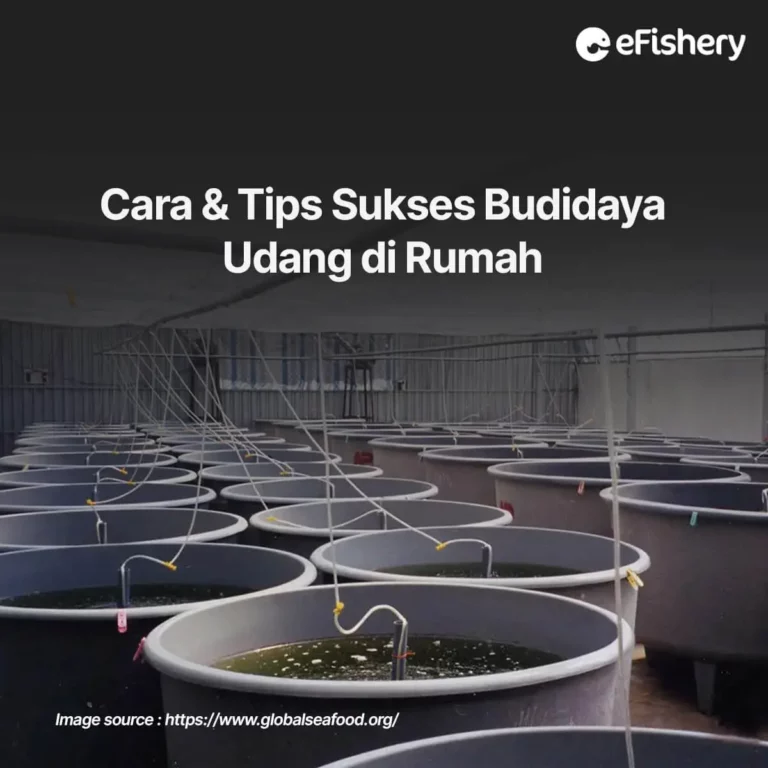Artikel Ini Telah Direview Oleh:

Muhammad Mustofa
Praktisi Budidaya Udang
Not only in ponds, now shrimp farming at home can be done easily. Cultivating shrimp at home is suitable for those of you who want to learn to cultivate shrimp from scratch. If taken seriously, shrimp farming at home can generate high profits and can expand the cultivation business. Come on, read this article to find out how and the capital needed to get started!
Household Scale Shrimp Cultivation
Shrimp is a fishery commodity with increasing demand and prices. With the delicacy it produces, shrimp has become a food that is loved by many people. Not surprisingly, the existence of shrimp is increasingly sought after.
This really opens up opportunities for those of you who want to start a shrimp farming business. There is no need for too much capital, shrimp farming can be started at home by utilizing existing vacant land. There are many types of shrimp that you can cultivate at home, including: vannamei shrimp, estuarine prawns, giant prawns, rice prawns, ragang prawns, red palm prawns, and lar prawns.
This household scale shrimp farming is a modification of traditional cultivation by adjusting the volume or area of the shrimp enlargement plots. Modifications are made so that the existing technology and methods can run properly and correctly even though the business capital spent is relatively small. Curious about how and how much capital is needed? Read on!
Tools and Materials Required
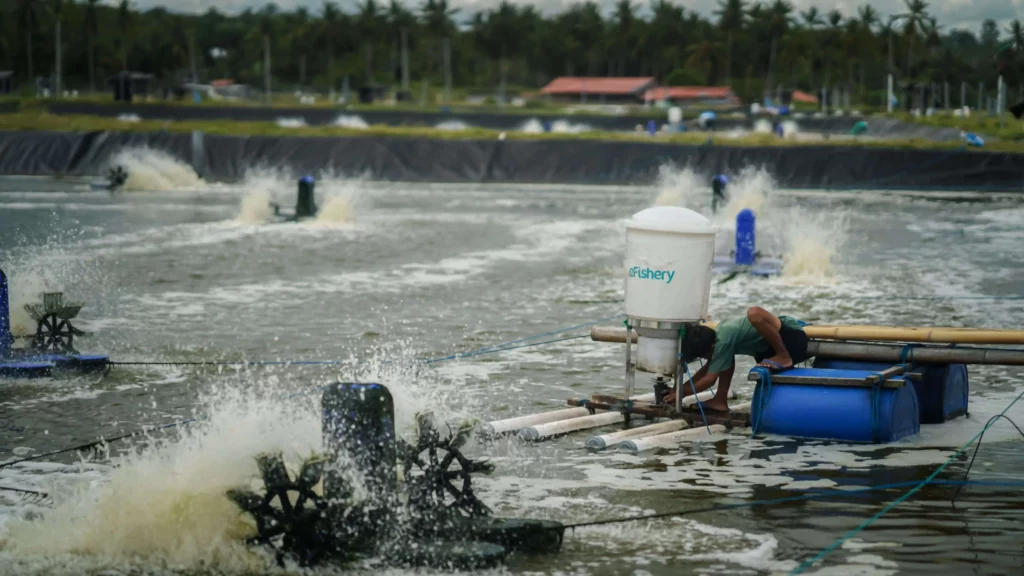
Tools for Shrimp Cultivation at Home
The equipment that you can use to cultivate shrimp at home is a modification of the existing equipment in traditional ponds which consists of:
- Pond plot
- Water pump
- Water wheel
- Harvest equipment
- Pool cleaner
The use and innovation of the above equipment are adapted to the conditions and characteristics of pond land, so that their application can be more effective and efficient.
Materials for Shrimp Cultivation at Home
To cultivate shrimp at home, the materials you can use are:
- Shrimp seeds
- Shrimp feed
- Probiotics
- Feed additives
- Fertilizer
Apart from the five ingredients above, if there are other materials recommended by aquaculture experts to maintain the quality of shrimp production, don't forget to include them, ladies and gentlemen!
Capital & Cost Analysis of Shrimp Cultivation at Home
After knowing the tools and materials needed, it's time for you to do business analysis in shrimp farming at home. In shrimp farming at home, there are 2 types of capital that must be prepared, namely capital that is only issued at the beginning of cultivation and capital that is issued every month.
Speaking of capital, one of the capital that you must prepare is capital for ponds or cultivation media. uThe size of the shrimp pond can be adjusted to the availability of land in your own house. Here, the assumption that the pool used is a round tarpaulin pool with a diameter of 3m. Come on, see the price of a pool of this size and details another start-up capital!
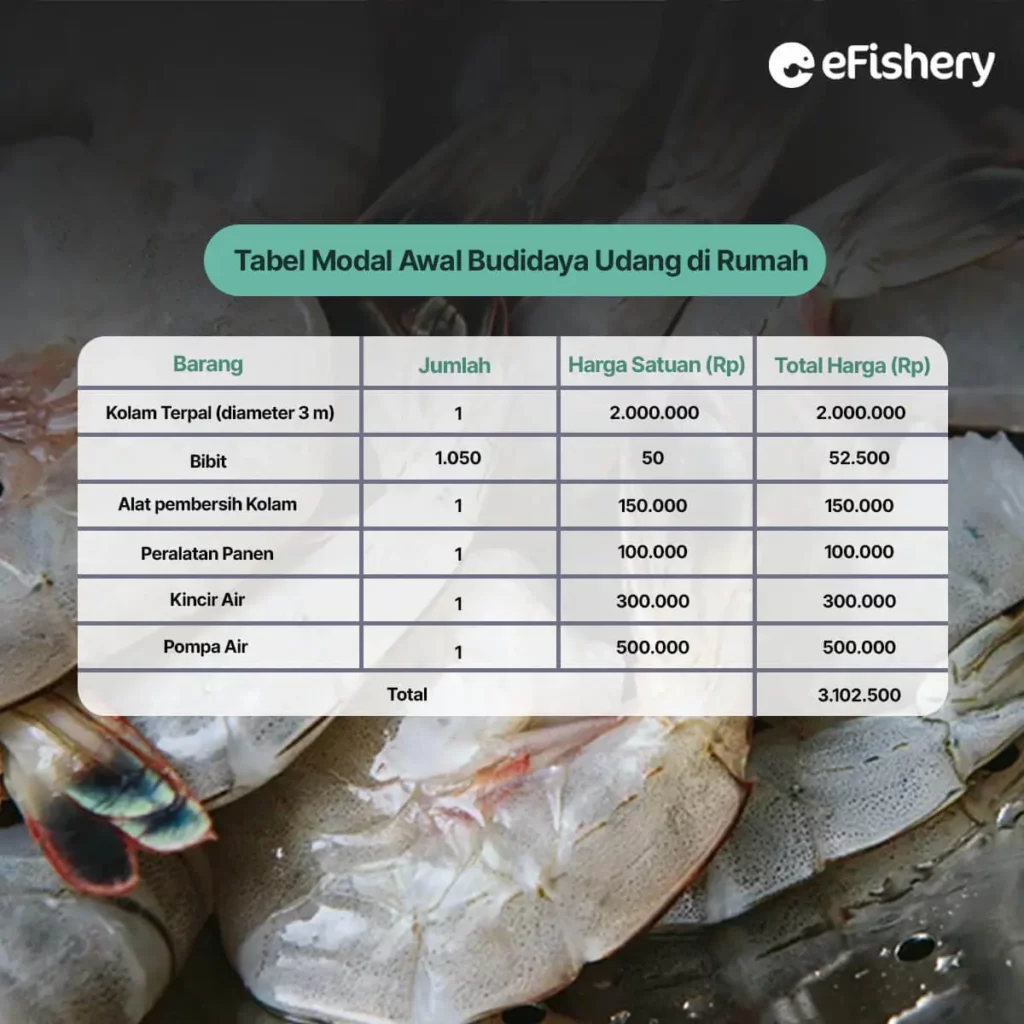
In addition to the costs above, there are costs that you must pay each month. The amount of this fee is determined from the time of 1 cycle of shrimp farming. To achieve sizes 50, usually shrimp takes 3 months. In shrimp farming if shrimp is defined as sizes 50, meaning there are 50 shrimp in every 1 kg. Come on, see the table below to find out the amount that must be spent for 3 months of cultivation!
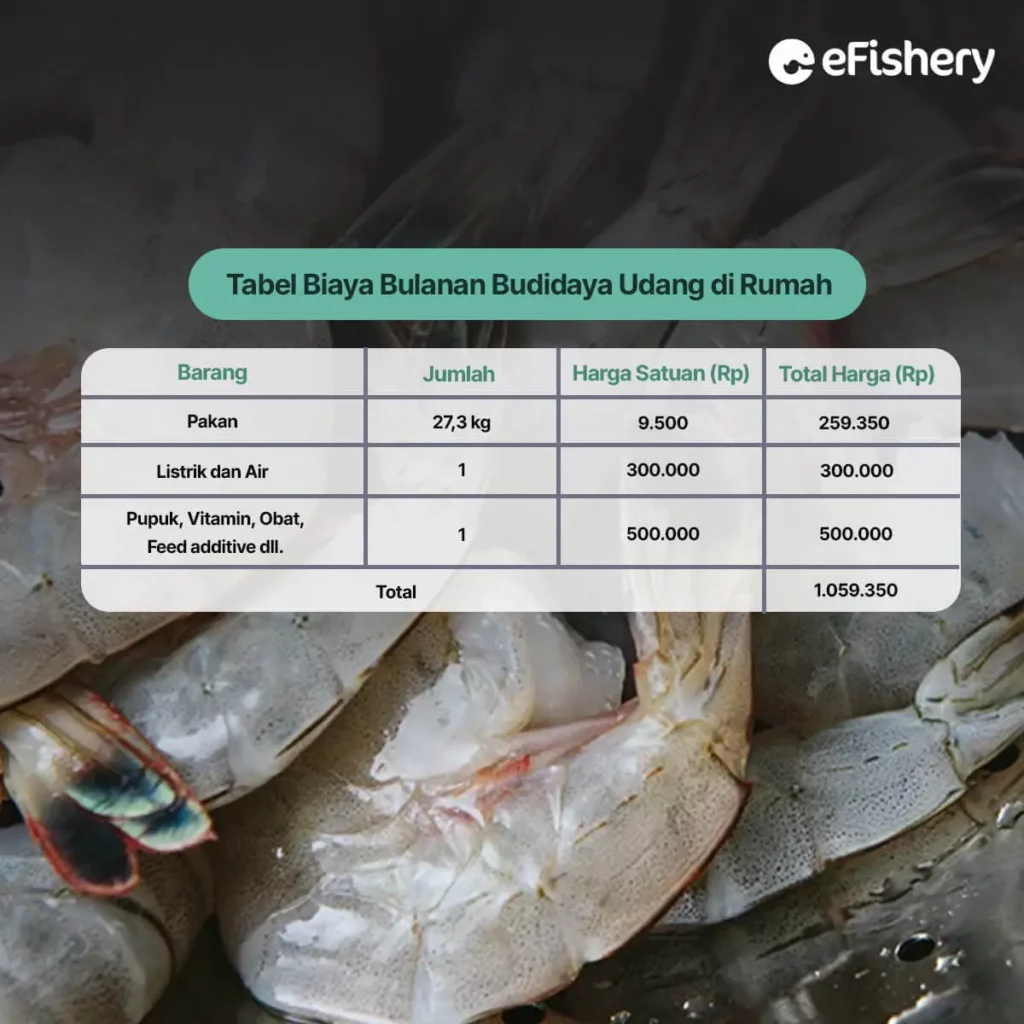
With the calculation above, the cost of cultivating shrimp at home that you need to spend is IDR 1,059,350 per month. These costs are estimates only. If you want to add workers and other tools during the cultivation cycle, of course the monthly costs that you have to pay for in the family will be higher.
Household Scale Shrimp Cultivation Method
Like shrimp farming in general, there are several stages in 1 cultivation cycle that you must do before the harvest arrives. Come on, learn together!
1. Land and Water Preparation
To cultivate shrimp at home, first you can prepare the land for placing the shrimp pond. Make sure the land is enough for a pool and not too small for you to be able to do activities around it. To make cultivation costs cheaper and preparation easier, you can use a tarpaulin pond. The tarpaulin pool is used so that you don't have to bother digging the ground. Just level the surface of the ground and clean it from scattered trash. After the ground is clean and level, the tarpaulin pool is ready to be placed.
After the tarpaulin pool is laid, it's time to do the pool water filling stage. Filling the water should be done 10-7 days before the shrimp fry are put into the pond. This is done to grow microorganisms that can become natural food for shrimp. In order for the shrimp to grow well, make sure the pond has a pH of 6-7 and a temperature of 28–30 °C.
Keep in mind, if you want to cultivate this type of vannamei shrimp at home, then it's necessary treatments especially because vannamei shrimp usually use brackish water or sea water. Whereas shrimp farming at home usually uses fresh water which has a lower salinity level than brackish water so it cannot support the growth of vannamei shrimp.
2. Selection and Spread of Seeds
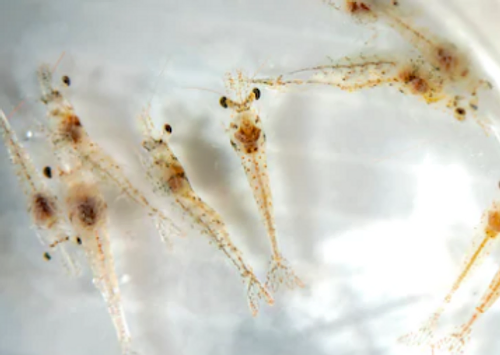
To get fry of the highest quality, you can buy fry from shrimp fry cultivators (hatchery) recommended by Aquaculture experts. When choosing fry, make sure you choose fry with the following characteristics:
- Responsive and active
- Perfect physique (2 antennae, clean eyes, and a full gut)
- Straight body when swimming
- Uniform size in order to avoid cannibalism between fellow shrimp and facilitate harvesting
When the perfect shrimp fry have been obtained, it's time to spread the shrimp fry in the home pond. First, you can enter the shrimp fry slowly using a small container so that the shrimp don't get stressed. Shrimp fry are very easy to stress. Another way that you can use to avoid stress on the shrimp is to add fry when the weather is not too hot in the afternoon or at night.
3. Treatment and Drugs
Various treatments such as giving probiotics and multivitamins must be done to maintain the health of the shrimp. Ponds must also be given a disinfectant to inhibit the growth of microorganisms.
Treatment can also be done by choosing the right technique for cultivation, one of which is the biofloc technique. Shrimp cultivation techniques with the biofloc system have been proven to be able to overcome water quality problems in ponds during rearing and emergence of disease in shrimp. This technique is carried out by mixing various microbes, detritus, and organic particles. The use of biofloc technology in shrimp farming can improve water quality, increase feed efficiency, and inhibit disease development during cultivation.
4. Feed Management
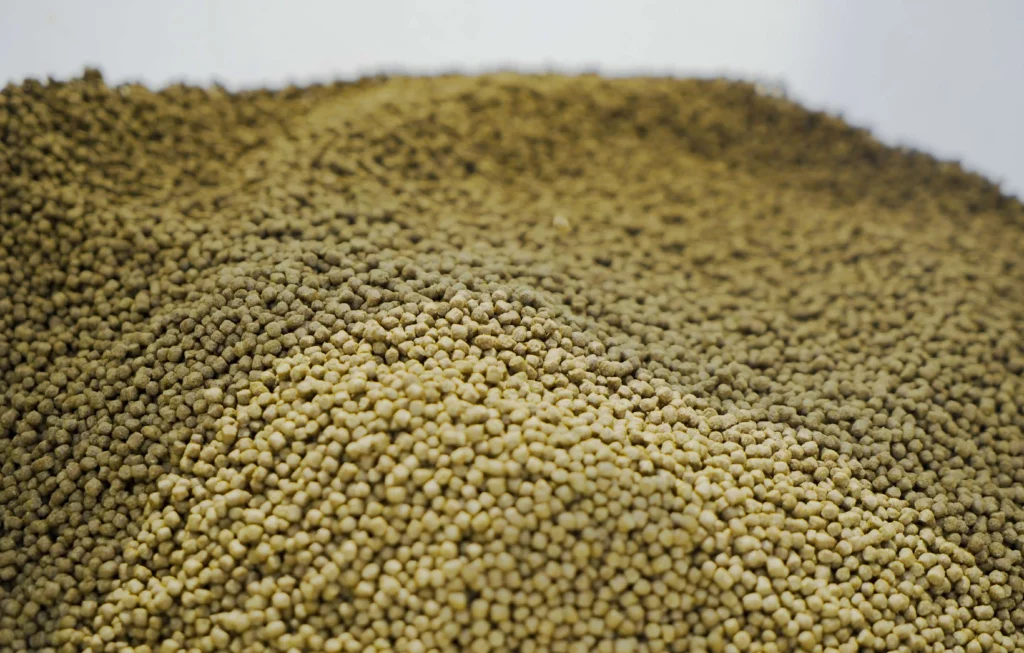
Feed is a component that costs a lot. Therefore, the feed must be properly regulated so that you do not suffer losses. For shrimp, feed is divided into 3 types, namely flour feed (for shrimp aged <15 days), granola/crumble feed (for shrimp aged 16-45 days), and pellets (for shrimp aged 46-120 days).
5. Harvest
Shrimp harvest is carried out when the shrimp have reached consumption size and can be sold at high prices or when the shrimp have reached a size of 50 heads/kg. Before harvesting, pond water should be limed first to prevent molting (shell replacement process) during harvest. To maintain the quality of the shrimp, harvest can be done in whole (total harvest) or in part (partial harvest) using nets.
Learn Shrimp Cultivation with the Learning Cultivation Feature on eFarm
Need Help Regarding Shrimp Cultivation Business?
Fill in your personal data in the following form. Our team will immediately contact you via the number cellphone attached. Make sure the data entered is correct.
Cultivating shrimp at home will be very profitable if you take it seriously. As the saying goes, little by little it becomes a hill. Just like shrimp farming, if your shrimp farming is more successful, over time you can have a large shrimp pond with even higher profits.
To find out more about shrimp farming, you can get it in features Learn Cultivation that's in the app eFarm. eFarm is the application of eFishery which provides various solutions for your shrimp farming problems. Apart from being able to enrich yourself with the knowledge of shrimp farming, in the application eFarm You can also consult directly with Aquaculture experts who can help with various cultivation problems.
Have application eFarm on Google Play Store now!

Muhammad Mustofa - Praktisi Budidaya Udang
Berpengalaman sebagai Asisten Dosen Universitas Pekalongan dan kini menjadi Online Technical Capability Development di eFishery
Questions Regarding Shrimp Cultivation at Home
Yes, shrimp farming can be done at home by adjusting the size of the pond and the availability of land that you have.
Shrimp can reach their ideal size within 3-4 months.
- http://perikanan.unikal.ac.id/wp-content/uploads/2018/05/Manajemen-tambak-skala-rumah-tangga.pdf
- https://www.benurtop.com/post/ciri-benur-udang-sehat-dan-berkualitas-unggul
- http://www.djpb.kkp.go.id/arsip/c/446/BUDIDAYA-UDANG-SKALA-RUMAH-TANGGA/?category_id=14
